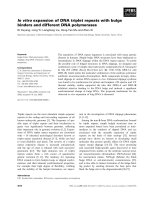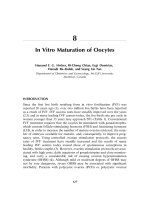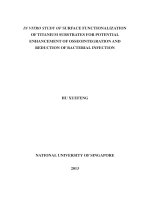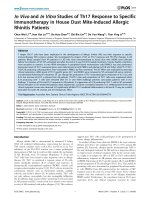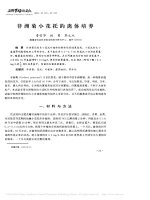In vitro impact of Indian propolis (Bulandshahr, Uttar Pradesh) and antibiotics on Staphylococcus spp. isolated from milk of cows with mastitis
Bạn đang xem bản rút gọn của tài liệu. Xem và tải ngay bản đầy đủ của tài liệu tại đây (549.68 KB, 7 trang )
Int.J.Curr.Microbiol.App.Sci (2019) 8(3): 1789-1795
International Journal of Current Microbiology and Applied Sciences
ISSN: 2319-7706 Volume 8 Number 03 (2019)
Journal homepage:
Original Research Article
/>
In vitro Impact of Indian Propolis (Bulandshahr, Uttar Pradesh) and
Antibiotics on Staphylococcus spp. Isolated from Milk of Cows with Mastitis
A.M.A. Alolofi1*, R.K. Pandey1 and R.P. Shah2
1
Department of Animal Husbandry and Dairying, Institute of Agricultural Sciences,
Banaras Hindu University, Uttar Pradesh, Varanasi-221005, India
2
Nepal Agricultural Research Council, Agricultural Research Station, Pakhribas,
Dhankuta, Nepal, India
*Corresponding author
ABSTRACT
Keywords
Mastitis, Methanol
extract of Indian
propolis,
Antibiotics,
Staphylococcus spp.
Article Info
Accepted:
15 February 2019
Available Online:
10 March 2019
Mastitis is one of the major factors obstructing the progress of the dairy industry. The use
of antibiotics has been related with antibiotic-resistant pathogens. Consequently, several
studies have been done in order to find natural alternatives. One of these alternatives is
propolis which has been identified as an appropriate option according to recent studies of
antibacterial, antiviral, antifungal, and antiprotozoal activity. The aim of this study was to
test In Vitro the antimicrobial activities of some commercial antibiotics and methanol
extract of Indian propolis (MEIP) against Staphylococcus spp. Isolated from mastitisinfected cow milk from the Gowshala (dairy farm), Department of Animal Husbandry and
Dairying, Institute of Agricultural Sciences, Banaras Hindu University, Varanasi, India.
The effectiveness of antibiotics and MEIP in inhibiting growth of Staphylococcus spp. was
Ciprofioxacin 5μ, Norfloxacin 10μ, Erythromycin 15μ, Doxyciclin 30μ, Lincomycin 2μ,
Offloxacin 5μ and Cefalexin 30μ are susceptible, while Bactrin 25μ, Ceftioxone 30μ,
Gentamycin 10μ, Clarithromycin 15μ and Azithromycin 15μ besides MEIP are
intermediate and Cefradine 30μ, Cloxacillin 30μ and Amoxycillin 10μ are resistant.
Introduction
Milk production is an important agricultural
sector in India which plays a significant role in
the Indian economy, and successful endeavors
of crossing local low-milk-yielding cattle with
lactating cows have been producing animals of
high milk potential, the physiological stress
and strain of heavy milk production, deep
caudo-ventral placement of udder, large size
and carriage of large quantity of milk by the
udder makes them more sensitive and prone to
injury and subsequent udder infection and
inflammation resulting into mastitis (Joshi
2006). Subclinical mastitis is a flock issue
because it includes a reservoir of infections
which could be transmitted to other animals of
a herd. While clinical mastitis is an individual
problem and it is characterized by changes in
the udder and the milk drawn from it. An
average decrease in milk yield was estimated
as 50% due to the clinical mastitis and 17.5%
1789
Int.J.Curr.Microbiol.App.Sci (2019) 8(3): 1789-1795
due to the subclinical mastitis (Joshi 2006).
Mastitis is a main factor that is obstructing the
progress required in the dairy industry, which
is one of the destructive elements of the
economy (Erskine et al., 2003; McDougall et
al., 2009). Anti-mastitis is usually treated
during the period of lactation or none-lactating
by direct injection into the udders.
Nevertheless, the use of antibiotics in animal
husbandry has been related with selection of
antibiotic-resistant pathogens and the presence
of antibiotic residues in the food chain (Van
Eenennaam et al., 1993; Nickerson 2009).
Consequently, many countries prohibit the use
of antibiotics in raising livestock and restrict
the importation of products derived from
antibiotic-treated
animals
(Oeztuerk;
Sagmanligil 2009). As a consequence, several
studies have been done in order to discover
alternative feed additives, which are natural
and accepted by consumers such as natural
antimicrobial products. Among these, propolis
has attracted much attention in recent years
because of its antibacterial, antiviral,
antifungal, and antiprotozoal activity and its
antibacterial activity was mainly ascribed to
flavonoids or to a synergism between some
components.
approximately (50% resins, 30% waxes, 10%
essential oils, 5% pollen and 5% of various
organic compounds) (Salation et al., 2005).
The chemical structure of propolis is complex;
flavonoid and (hydroxyl) cinnamic acid
derivatives are considered to be the essential
biologically active constituents in propolis
extract. It also includes many different
chemical
components
according
to
geographical regions, climate and bee strain
(Bankova 2005). Due to the complex structure
of propolis it cannot be used as raw material
but it can be used properly after extraction
with several types of solvents which take
away the inert material and preserve the
desired compounds. The widespread solvents
that are utilizing for extracting propolis as
follows: methanol, ethanol, water, chloroform,
dichloromethane, acetone and ether. The
antimicrobial activities of some commercial
antibiotics and methanol extract of Indian
propolis (MEIP) have been tested In Vitro
against Staphylococcus spp. isolated from
mastitis-infected cow milk from the Gowshala
(dairy farm), Department of Animal
Husbandry and Dairying, Institute of
Agricultural Sciences, Banaras Hindu
University, Varanasi, India.
Materials and Methods
The structure of propolis is a phrase of
corresponding concentrations of its component
depends on the variety of the honeybee Apis
Mellifera as well as the phytogeographic
characteristics around the beehive (Marcucci
1995). Propolis structure is extremely
complex: its main constituents are beeswax,
resin and volatiles, but also pollen, amino
acids, flavonoids (major components: rutin,
quecertin, galangin) and caffeic acid phenetyl
ester were identified, among others
(Kumazawa et al., 2004). In other words,
propolis is a complex mixture of bee released
compounds and resin of plant. The proportion
of the different substances in the propolis
depend on the place and time of collection. In
broad terms, raw propolis is consisting of
The milking herd of dairy cows of the
Gowshala (dairy farm), which is including 90
lactating cows (Indigenes cross-bred and
lactating cows), Department of Animal
Husbandry and Dairying, Institute of
Agricultural Sciences, Banaras Hindu
University, Varanasi, India have been selected
to investigate for mastitis during milking
period.
Milk sample
The milk samples were taken from the cows
which are infected with mastitis from the flock
of the Gowshala (dairy farm), for isolating
Staphylococcus spp., which is considered the
1790
Int.J.Curr.Microbiol.App.Sci (2019) 8(3): 1789-1795
essential reason behind the infection of
mastitis.
a filter paper (Whatman No. 41)
California Mastitis Test (CMT)
Bacterial isolates and inoculum preparation
To identify and isolate the bacteria, 0.1 mL of
milk sample were spread onto 8% blood agar
plates and then incubated overnight at 37°C.
The microbial strains were presumptively
identified on the basis of morphology,
hemolysis pattern and Gram staining of the
colonies, and then colonies of each microbial
strain were streaked on blood agar to obtain a
pure culture. After identification, colonies of
Staphylococcus spp. were stored at -20°C in
Brain Heart Infusion agar with glycerol.
Origin propolis
Propolis sample was collected in December
2016 to March 2017 from Bulandshahr district
in the Meerut region in the North India state of
Uttar Pradesh located between Ganga and
Yamuna rivers, which is situated 77.0° and
78.0° east longitudes and between 28.4° south
and 28.0° north latitudes. The district is
237.44 meters above sea level.
Propolis Extracts
Propolis has a complicated composition and
cannot be utilized directly in the raw form.
The usual process is the use of a solvent
(National Committee for Clinical Laboratory
Standards, 2003), which must strip the inert
material
and
maintain
the
required
compounds. So the major solvents used for
extraction of bioactive contents are ethanol,
methanol and water. Crude propolis contains
plant resins, wax and insoluble substance.
There are many methods of extracting the
biological components of propolis. The
sample of propolis were kept at -30˚C for 24
hours than crush to fine powder and then
extracted in 97% methanol with shaking twice
in day at room temperature for 14 days, after
that the methanol solution was filtered through
The California mastitis test uses to determine
somatic cell counts (SCC) which measure the
health of cow's udder. The DNA reacting with
the test reagent which disrupts the cell
membrane of somatic cells in the milk sample.
The test has been conducted on the lactating
herd of the Gowshala (dairy farm) Banaras
Hindu University to identify the cows with
mastitis.
Antimicrobial Susceptibility
The examinations antimicrobial activity of
Methanol Extract of Indian Propolis (MEIP)
were proceeded by the disc diffusion method
based on the guidelines of the National
Committee for Clinical Laboratory Standards
(2003). Several commercial antibiotics were
also tested under the same condition,
specifically: Ciprofioxacin 5μ, Norfloxacin
10μ,
Bactrin
25μ,
Ceftioxone
30μ,
Gentamycin 10μ, Cefradine 30μ, Cloxacillin
30μ, Erythromycin 15μ, Doxyciclin 30μ,
Lincomycin 2μ, Offloxacin 5μ, Cefalexin 30μ,
Clarithromycin 15μ, Azithromycin 15μ and
Amoxycillin 10μ.
Determination
Concentration
of
Minimum
Inhibitory
Minimum Inhibitory Concentration (MIC) was
identified as the lowest concentration of the
Indian propolis extract which prevented the
growth of the examined microorganisms. All
groups were noticed visually and MIC values
were registered as had no visible turbidity.
Data analysis
The data represent observations from at least
duplicate samples obtained from two
experiments carried out independently.
1791
Int.J.Curr.Microbiol.App.Sci (2019) 8(3): 1789-1795
Results and Discussion
Rate of occurrence of Mastitis based on
(CMT) and Microbiological examination
The herd of dairy cows of the Gowshala (dairy
farm), which is including 90 lactating cows
have been investigated, and the results of
California Mastitis Test (CMT) showed that
53 subclinical and 2 clinical mastitis.
Of the 53 milk cow samples with subclinical
mastitis, in a scale of scores from 1 to 5,
55.4% showed scores 2 and 3, while the
microbiological analysis appeared only 8.3%.
Furthermore, the other samples 44.6% showed
scores 4 and 5, and only 6.3% conformed by
microbiological analysis.
Effectiveness of antibiotics and MEIP in
inhibiting growth of Staphylococcus spp.
The effectiveness of antibiotics and Methanol
Extract of Indian Propolis (MEIP) in
inhibiting growth of Staphylococcus spp.
presented in figure 1 which clarified that
Ciprofioxacin
5μ,
Norfloxacin
10μ,
Erythromycin
15μ,
Doxyciclin
30μ,
Lincomycin 2μ, Offloxacin 5μ and Cefalexin
30μ have higher effectiveness in inhibiting of
Staphylococcus spp. While Bactrin 25μ,
Ceftioxone
30μ,
Gentamycin
10μ,
Clarithromycin 15μ and Azithromycin 15μ
besides MEIP are identified moderate
effectiveness in inhibiting of Staphylococcus
spp. Whereas Cefradine 30μ, Cloxacillin 30μ
and Amoxycillin 10μ did not show any
effectiveness in inhibiting of Staphylococcus
spp.
In light of table 1 and figure 2 antibiotics and
Methanol Extract of Indian Propolis (MEIP) in
this study have been categorized into three
groups susceptible, intermediate, and resistant
antibiotic accordingly to inhibit the growth of
Staphylococcus spp. The first group is
including susceptible antibiotics, as the
diameter
of
inhibitions
growth
of
Staphylococcus spp. by Doxyciclin 30μ
(30mm), Cefalexin 30μ (27mm), Norfloxacin
10μ (26mm), Ciprofioxacin 5μ (25mm),
Erythromycin 15μ (23mm), Offloxacin 5μ
(23mm) and Lincomycin 2μ (22mm). Whereas
the second group is including intermediate
antibiotics, as the diameter of inhibitions
growth of Staphylococcus spp. by Bactrin 25μ
(15mm),
Ceftioxone
30μ
(12mm),
Gentamycin 10μ (13mm), Clarithromycin 15μ
(14mm) and Azithromycin 15μ (13mm), as
well as MEIP has been identified as
intermediate which its diameter of inhibitions
growth is measured as (11mm). However, the
third group is represented in resistant
antibiotics, which is comprising: Cefradine
30μ, Cloxacillin 30μ and Amoxycillin 10μ,
considering that they did not show any effect.
Pinto, et al., (2001) define the impact of green
propolis extracts on bacteria isolated from
milk of cows with mastitis that the inhibition
zones (8.7-11 mm).
The susceptibility of Methanol Extract of
Indian Propolis (MEIP) in inhibiting growth of
Staphylococcus spp. has been estimated at
between 9mm and 11mm, as shown in figure
3.
Santos Neto et al., (2009) found that for both
the ethanolic and aqueous extracts of the green
propolis, MIC was determined for the isolate
of Staphylococcus spp. that showed the largest
diameters of the inhibition zones.
On the other hand, the consequence of the
slight solubility of propolis components
(phenolics, flavonoids, among others), Pinto,
et al., (2001) found that aqueous extract of
propolis did not appear any in vitro
antimicrobial effect against strains of
Staphylococcus aureus isolated from milk of
cows suffering from mastitis.
1792
Int.J.Curr.Microbiol.App.Sci (2019) 8(3): 1789-1795
Table.1 Diameter of inhibitions and Degree of sensitive of antibiotics and MEIP in inhibiting
growth of Staphylococcus spp.
Antibiotic
Ciprofioxacin 5μ
Norfloxacin 10μ
Bactrin 25μ
Ceftioxone 30μ
Gentamycin 10μ
Cefradine 30μ
Cloxacillin 30μ
Erythromycin 15μ
Doxyciclin 30μ
Lincomycin 2μ
Offloxacin 5μ
Cefalexin 30μ
Clarithromycin 15μ
Azithromycin 15μ
Amoxycillin 10μ
Methanol Extract of Indian
Propolis (MEIP)
Diameter of
inhibition (mm)
25
26
15
12
13
0
0
23
30
22
23
27
14
13
0
11
Degree of sensitive
Sensitive
Sensitive
Moderate
Moderate
Moderate
Resistant
Resistant
Sensitive
Sensitive
Sensitive
Sensitive
Sensitive
Moderate
Moderate
Resistant
Moderate
Fig.1 Effectiveness of antibiotics and MEIP in inhibiting growth of Staphylococcus spp
CIP: Ciprofioxacin 5μ, NX: Norfloxacin 10μ, TS: Bactrin
25μ, CRO: Ceftioxone 30μ, GEN: Gentamycin 10μ, CFD:
Cefradine 30μ, CX: Cloxacillin 30μ
1793
E: Erythromycin 15μ, DO: Doxyciclin 30μ, L:
Lincomycin 2μ, OF: Offloxacin 5μ, CP: Cefalexin 30μ,
CLR: Clarithromycin 15μ, AZM: Azithromycin 15μ, AX:
Amoxycillin 10μ
Int.J.Curr.Microbiol.App.Sci (2019) 8(3): 1789-1795
Fig.2
Fig.3 Effectiveness of Indian propolis extraction in inhibiting growth of Staphylococcus spp.
It is concluded that in vitro test against
Staphylococcus
spp.
showed
that
Ciprofioxacin, Norfloxacin, Erythromycin,
Doxyciclin, Lincomycin, Offloxacin and
Cefalexin were highly effective against
Staphylococcus spp. while MIPE showed the
similar result with Bactrin, Ceftioxone,
Gentamycin,
Clarithromycin,
and
Azithromycin which was moderately
effective. Cefradine, Cloxacillin and
Amoxicillin were found resistant against
Staphylococcus spp. The diameter of
inhibition growth against Staphylococcus
spp. was found to be 11 mm with MIPE
which was similar to moderate group i.e
Bactrin
15mm,
Ceftioxone
12mm
Gentamycin 13mm, Clarithromycin 14mm,
and Azithromycin 13mm. Cefradine 30μ,
1794
Int.J.Curr.Microbiol.App.Sci (2019) 8(3): 1789-1795
Cloxacillin 30μ and Amoxicillin 10μ,
considering that they did not show any
effect.
Nickerson, S. Control of heifer mastitis:
antimicrobial treatment-an overview. Vet
Microbiol, 2009, 134, 128–135.
Oeztuerk, H., Sagmanligil, V. Role of live
yeasts on rumen ecosystem. DTW.
Deutsche Tierarztliche Wochenschrift,
Hannover, Germany, 2009, 116, 244248.
Pinto, M.S., Faria, J.E., Message, D., Cassini,
S.T.A., Pereira, C.S., Gioso, M. Effect of
green propolis extracts on pathogenic
bacteria isolated from milk of cows with
mastitis. Braz. J. Vet. Res. Anim. Sci.,
2001, 38, 278-83.
Sachin Joshi, BAIF Development Research
Foundation and Central Research
Station,
Uruli
Kanchan,
Pune,
Maharashtra 412202, India. Ann. N.Y.
Acad. Sci. 2006, 1081, 74–83. New York
Academy
of
Sciences.
doi:
10.1196/annals.1373.007.
Salatino, A., Teixeira, E.W., Negri, G.,
Message, D. Origin and chemical
variation of Brazilian propolis. Evid.
Based Complement. Alternat. Med.,
2005, 2, 33-8.
Santos Neto, T.M., Mota1, R.A., Silva1,
L.B.G., Viana, D.A., Lima-Filho, J.L.,
Sarubbo, L.A., Converti, A., and Porto,
A.L.F. Susceptibility of Staphylococcus
spp. Isolated from Milk of Goats with
Mastitis to Antibiotics and Green
Propolis Extracts. Letters in Drug Design
& Discovery, 2009, 6, 63-68.
Van Eenennaam, A., Cullor, J., Perani, L.,
Gardner, I., Smith, W., Dellinger. J.,
Guterbock, W., Jensen, L. Evaluation of
milk antibiotic residue screening tests in
cattle with naturally occurring clinical
mastitis. J Dairy Sci., 1993, 76, 3041–
3053.
Acknowledgments
The authors thank Khaled Alselwi and
Sadeq Rawdhan for excellent technical
assistance.
References
Bankova V. Recent trends and important
developments in propolis research. J
Evid Based Complementary Altern Med,
2005, 2:29–32.
Erskine, R., Wagner, S., DeGraves, F. Mastitis
therapy and pharmacology. Vet Clin N
Am Food Anim Pract, 2003, 19, 109–
138.
Kumazawa, S., Hamasaka, T., Nakayama, T.
Antioxidant activity of propolis of
various geographic origins. Food Chem.,
2004, 84, 329-39.
Marcucci,
M.C.
Propolis:
chemical
composition, biological properties and
therapeutic activity. Apidologie, 1995,
26, 83-99.
McDougall, S., Parker, K., Heuer, C.,
Compton, C. A review of prevention and
control of heifer mastitis via nonantibiotic strategies. Vet Microbiol,
2009,134, 177–185.
National Committee for Clinical Laboratory
Standards. Performance Standards for
Antimicrobial Disks Susceptibility Tests,
Approved standard, 8th ed., M2-A8 v.
23, n. 1 replaces M2-A7, v. 20, n.1.
NCCLS: Wayne, PA, USA, 2003.
How to cite this article:
Alolofi, A.M.A., R.K. Pandey and Shah, R.P. 2019. In vitro Impact of Indian Propolis
(Bulandshahr, Uttar Pradesh) and Antibiotics on Staphylococcus spp. Isolated from Milk of
Cows with Mastitis. Int.J.Curr.Microbiol.App.Sci. 8(03): 1789-1795.
doi: />
1795

